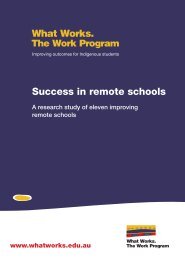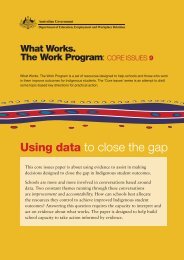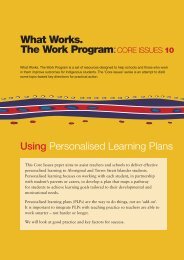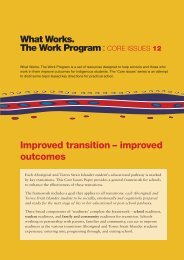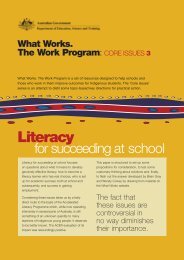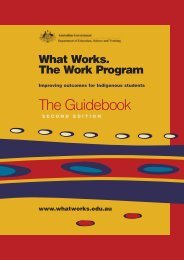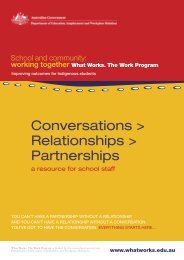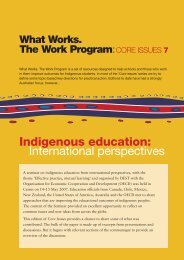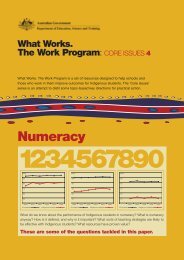Bound for Success Scope and Sequence Statements
Bound for Success Scope and Sequence Statements
Bound for Success Scope and Sequence Statements
- No tags were found...
Create successful ePaper yourself
Turn your PDF publications into a flip-book with our unique Google optimized e-Paper software.
ENGLISHReading, Viewing <strong>and</strong> Interpreting Imaginative TextsIn Year 1the student:In Year 2the student:In Year 3the student:In Year 4the student:In Year 5the student:In Year 6the student:In Year 7the student:In Year 8the student:In Year 9the student:In Year 10the student:o reader / viewerinterpretations of texts areinfluenced by theknowledge <strong>and</strong> values ofthe groups to which theybelong, <strong>and</strong> by their ownexperienceso that imaginative texts,including songs, canreflect or shape thecreation of identity (e.g. IAm/We Are Australian bythe Seekers; I Still CallAustralia Home, TheAnzac)o reader/ viewer responsesto characters <strong>and</strong>situations may vary atdifferent points within atexto experiences created intexts can help readers <strong>and</strong>viewers underst<strong>and</strong>themselves <strong>and</strong> others,their own world <strong>and</strong> thewider worldo readers / viewers choosewhether to accept or rejectpositions invited by textso readers <strong>and</strong> viewers maybe positioned to viewcharacters <strong>and</strong> ideas inparticular ways, <strong>and</strong> thatthese views may reflectcultural values <strong>and</strong> bequestioned, as in TheRabbits by John Marsden<strong>and</strong> Shaun Taninterprets these texts to:o draw conclusions aboutcharacters <strong>and</strong> majorideas using reference toparticular moments <strong>and</strong>incidentsinterprets these texts to:o identify the main topic ofa story through characters<strong>and</strong> eventso retell key eventso make connectionsbetween their ownexperiences <strong>and</strong>representations of people,places, events <strong>and</strong> thingsin textsinterprets these texts to:o identify the main topic ofa story through characters<strong>and</strong> key eventso retell key events insequence using texts suchas, Possum Magic byMem Foxo draw inferences fromdirectly-stateddescriptions <strong>and</strong> actionswhich are in closeproximity within the texto identify <strong>and</strong> reflect on thedescriptive words,images, facialexpressions, gestures <strong>and</strong>other textual resourcesused in texts to representpeople, places, events <strong>and</strong>thingsinterprets these texts to:o identify the main topic ofa story throughdescriptions of characters,settings, events <strong>and</strong> thingso retell key events <strong>and</strong>linked in<strong>for</strong>mation insequenceo draw inferences fromdirectly-stateddescriptions <strong>and</strong> actions(e.g. infer a character’sfeelings)o discuss how charactershave been portrayed in anegative or positive way(e.g. refer to the maincharacters in the students’favourite fairytales)o talk about how people,characters <strong>and</strong> eventscould have beenrepresented differently(e.g. more fairly) throughvisual <strong>and</strong> textualresourcesinterprets these texts to:o identify connectionsbetween plot, setting <strong>and</strong>characterso infer characters’ qualities<strong>and</strong> actions using textssuch as The Two Bulliesby Junko Morimotoo identify how visuallanguage has been used intexts, including howcolour, size, clothing,facial expressions <strong>and</strong>appearance representcharacterso discuss how characters<strong>and</strong> events have beenportrayed, by consideringboth positive <strong>and</strong> negativeperspectives (e.g.compare The Three LittlePigs to The True Story ofthe 3 Little Pigs! by JonScieszka <strong>and</strong> Lane Smith)o discuss their owninterpretations of textsread or viewed <strong>and</strong>provide details aboutcharacters, setting <strong>and</strong>eventsinterprets these texts to:o make connections fromdirectly-statedin<strong>for</strong>mation to identifymain ideaso infer characters’ qualities,motives <strong>and</strong> actionso identify aspects of subjectmatter that have beenomitted <strong>and</strong> suggest whyo identify how language hasbeen used to constructcharacters <strong>and</strong> events inparticular ways, includingpositive <strong>and</strong> negativeperspectivesinterprets these texts to:o infer messages developedthrough the storyline, asin The Short <strong>and</strong>Incredibly Happy Life ofRiley by Colin Thompson<strong>and</strong> Amy Lissiato identify how language(adjectives, verbs,adverbs) have been usedto contribute to theconstruction of characters<strong>and</strong> the role they play inthe ploto make judgements aboutcharacters <strong>and</strong> whether ornot they agree withdecisions they make <strong>and</strong>actions they takeo identify aspects of subjectmatter used in the textwhich contribute torepresentations ofcharacters, places <strong>and</strong>eventsinterprets these texts to:o infer meanings <strong>and</strong>messages developedthrough the storylineo identify how constructionof characters contributesto plot developmento draw conclusions aboutpossible reasons <strong>for</strong>characters’ behaviours<strong>and</strong> feelingso consider ethical choicesmade by variouscharacterso identify how aspects ofsubject matter used in thetext contribute torepresentations ofcharacters, places <strong>and</strong>eventsinterprets these texts to:o draw conclusions aboutexperiences represented intexts, suggest ways thesemay help readers/viewersunderst<strong>and</strong> themselves orothers, their owncommunity <strong>and</strong> the widerworld (e.g. Noah <strong>and</strong>Saskia – Who do you wantto be? AustralianChildren’s TelevisionFoundation)o identify the particular useof textual resourcesincluding evaluativeverbs (e.g. impressed) <strong>and</strong>subject mattero draw conclusions aboutthe major ideas referringwith some elaboration tosetting , incidents orconflicts, <strong>and</strong> the speech,thoughts, feeling <strong>and</strong>interaction of characterso identify techniques usedto develop plot <strong>and</strong> createemotional responses,including comparison,contrast, exaggeration,juxtapositiono make connections amongtexts identifyingreferences/allusions toother textso identify techniques usedto construct plot <strong>and</strong>create emotionalresponses, includingcomparison, contrast,exaggeration,juxtaposition, thechanging of chronologicalorder, or the expansion<strong>and</strong> compression of timeo identify uses of referencesto other texts <strong>and</strong> howthese contribute tomeaninginterprets these texts to:o identify how theconventional plots,settings, characters <strong>and</strong>resolutions associatedwith different text typeswork to position readers<strong>and</strong> viewers to acceptcertain culturalassumptionso identify how linguistic,visual, gestural, spatial<strong>and</strong> audio resources areused to indicate shifts innarrative points of viewo identify whose interestsare being served throughthe patterning of differentresourcesknows:• that print contains aconstant message – whilewords in an oral storymay change, the words ofa written story do not• left-to-right <strong>and</strong> top-tobottomorientation ofprint• one-to-onecorrespondence betweenknows:o that narratives typicallyinclude sequenced,connected events oractions <strong>and</strong> a conclusiono that syllables affect therhythm in words (e.g. canclap syllables todemonstrate rhythm)• the difference between astatement, question <strong>and</strong>knows:o that the typical genericstructure of narrativesincludes orientation,complication, resolutiono that stanzas, rhyme <strong>and</strong>rhythm are features ofrhymed verses• the difference between astatement, question,comm<strong>and</strong> <strong>and</strong>knows:o the function of thedifferent stages ofimaginative texts (e.g. anorientation sets the scene<strong>and</strong> introduces <strong>and</strong>describes characters)o that clauses can representwhat is happening, who orwhat is taking part <strong>and</strong>under what circumstancesknows:o the typical genericstructure <strong>and</strong> purpose ofeach stage of a narrative,including the orientation,complication, resolutiono that a sequence of eventscan build upcomplications <strong>and</strong>resolutions to createtension <strong>and</strong> suspenseknows:o narratives can have morethan one complication <strong>and</strong>resolutiono some poems of particular<strong>for</strong>ms includingAustralian Ballad (e.g.The Man from Ironbarkby A.B. (Banjo) Paterson)o particular textualresources, includingevaluative verbs (thatknows:o the names <strong>and</strong> functionsof the common stages inthe generic structure of arange of text <strong>for</strong>ms <strong>and</strong>styles, includingadventure, fantasy <strong>and</strong>romance (e.g. innarratives – orientationsets the scene <strong>and</strong>introduces <strong>and</strong> describescharacters)knows:o figurative languageincluding similes,metaphors <strong>and</strong>personification, can beused to establishatmosphere <strong>and</strong> makefeelings or ideas moreconcrete <strong>and</strong> powerfulo some techniques used inpoetry, includingknows:o some techniques used inpoetry, includingalliteration <strong>and</strong>onomatopoeiao that imagery is used toestablish mood <strong>and</strong> makefeelings or ideas moreconcrete <strong>and</strong> powerful asin Refugees by DavidMillerknows:o A range of techniquesused in poetry includingalliteration,onomatopoeia,personification, similes<strong>and</strong> metaphorso some poems in a range of<strong>for</strong>ms (e.g. Corroboree byKath Walker /OodgerooNoonuccal <strong>and</strong>Jabberwocky by Lewis<strong>Bound</strong> <strong>for</strong> <strong>Success</strong> <strong>Scope</strong> <strong>and</strong> <strong>Sequence</strong> <strong>Statements</strong> V2 Page 4 Working Document Semester One 2007



